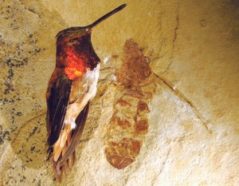When the giant ants went marching
A new study of an ancient fossil suggests that 50 million years ago, supersized ants went on a cross-continental trek

Today’s tiny ants are puny in comparison to some species that roamed North America nearly 50 million years ago. Scientists recently identified the fossilized remains of a giant ant queen two inches long. That’s as long as a hummingbird without its beak. If you saw one of these oversized insects approaching your picnic, you’d pack up and leave in a hurry. (Though, of course, there weren’t picnics back then; people hadn’t yet evolved.) But those giants are now extinct.
The new fossil is the first of its kind. Until now, scientists had never found the body of a giant ant in the Western Hemisphere. (They had, however, found a suspiciously large fossilized ant wing in Tennessee, but the rest of the ant remains missing.)
“Complete preserved specimens were not known until [the researchers] came up with this beautiful preserved fossil,” Torsten Wappler told Science News. Wappler, who did not work on the new study, is a paleontologist who studies ancient, giant ants at the University of Bonn in Germany.
In a new research paper, Bruce Archibald and his colleagues introduced the fossil. Archibald, from Simon Fraser University in Burnaby, Canada, is a paleoentomologist. He studies fossils to learn about ancient forms of insect life.
The fossil came from a 49.5-million-year-old rock originally dug up in Wyoming. But Archibald and his colleague Kirk Johnson at the Denver Museum of Nature & Science found it in the museum’s storage. The bug isn’t the largest ant ever found; slightly longer ants have been discovered in Africa and in fossils in Europe.
In general, larger ants are found in colder areas. But that rule doesn’t hold for the largest ant species in the world, which live in warmer regions. Those really big ants mostly dwell in the tropics, which are the warm areas of the world above and below the equator. (This region circles the planet like a wide belt.)
Archibald and his team say the ancient ant they found in the fossil probably also loved hot areas. The family of ants that the species belongs to is said to be thermophilic, which means heat-loving. This extinct family of ants lived in places where the average temperature was 68 degrees Fahrenheit or higher. These types of ants have been found on continents other than North America, which means that a long time ago, they must have gone on a long march.
The researchers suspect that these ants moved between continents by way of a land bridge that used to stretch across the North Atlantic Ocean. (The land bridge helps explain how many species, not just the ants, got from one side of the ocean to the other.) Other scientists who study the climate of ancient Earth say there were periods of time when the North Atlantic area warmed up long enough that ants could pass from one continent to another.
These stretches of warmth in the north also help explain why other scientists have found tropical species, like the ancient cousins of hippos or pollen from palm trees, in northern parts of the world that today have cooler temperatures.
POWER WORDS (adapted from the New Oxford American Dictionary)
climate The weather conditions in a particular area over a long time.
land bridge A connection between two landmasses, especially a prehistoric one that allowed humans and animals to colonize new territory before being cut off by the sea, as across the Bering Strait or the English Channel.
paleontology The branch of science concerned with fossil plants and animals.
species A group of living organisms consisting of similar individuals capable of exchanging genes or producing offspring.







